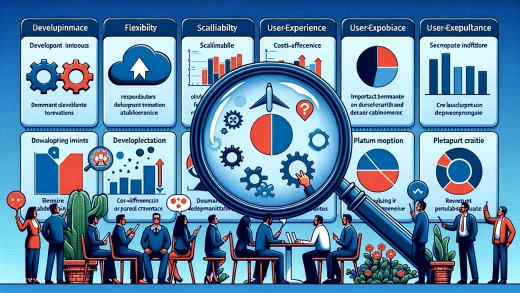Understanding AI-Driven Personalization
What Makes AI Personalization So Powerful?
Imagine walking into your favorite coffee shop, and the barista has already prepared your go-to drink, exactly how you like it. That’s the magic of AI-driven personalization—but in the digital world. Instead of one-size-fits-all experiences, apps fueled by AI learn about you: your preferences, habits, and even those quirky little behaviors you didn’t know you had.
At its core, AI-baked personalization is about crafting tailor-made moments at scale. It picks up on patterns from every tap, swipe, and click you make. And no, it’s not creepy—it’s smart. For instance:
- Streaming platforms suggesting movies that feel like they’re reading your mind.
- Shopping apps showing exactly the jacket you pictured wearing last week.
- Health apps nudging you with fitness routines that fit into your unpredictable schedule.
How AI Maps Your Digital DNA
Here’s where the geeky elegance lies: it’s all about data and algorithms doing the heavy lifting. Using predictive analytics, machine learning, and natural language processing, AI doesn’t just follow your lead—it anticipates it. Think of it as having a digital concierge who knows what you want before you do, minus the pretentious attitude. It’s not about overwhelming users but making them feel seen, understood, and, well… human.
Steps to Integrate AI Personalization into Apps

Start with Solid Foundations
Integrating AI personalization into your app isn’t about sprinkling some magic code and calling it a day. It all starts with understanding your users like never before. Picture this: instead of treating every app user like a stranger at a party, you’re rolling out the red carpet for each person. To do that, first, you need data – and lots of it. Build a strong foundation by gathering insights about user behavior, preferences, and habits. Think of this as the raw material your AI will sculpt into something spectacular.
- Track in-app activities: Which features get the most love? Where are users spending time?
- Use clever surveys or feedback prompts to dig deeper into user preferences.
- Connect with APIs or external systems that hold valuable user data.
Test, Tweak, Triumph
Once your foundation is built and your AI model starts making recommendations, don’t just sit back. This step is your app’s dress rehearsal! Test the outputs on a small user base. Are suggestions too generic, or are they nailing user expectations? For example, if your AI features a personalized music playlist, does it feel like the user’s best friend is curating it? If not, tweak it. Play around with different datasets, retrain your model, and repeat the process until it feels so seamless and intuitive you’ll wonder how your app ever lived without it.
Key Technologies Behind AI Personalization

Unmasking the Magic: Core Ingredients of AI Personalization
Ever wondered how an app seems to know you better than your best friend? The secret lies in a powerful mix of AI technologies working behind the scenes, like an orchestra creating a perfect symphony just for you. Let’s break it down:
- Machine Learning (ML): Think of this as the brainpower behind personalization. ML models analyze patterns in your choices—whether it’s your binge-worthy shows or that late-night coffee order—and adapt over time. Each interaction adds a brushstroke to your personal portrait.
- Natural Language Processing (NLP): Ever texted customer support and felt like they “got” you? That’s NLP in action. It deciphers human language, making recommendations sound less robotic and more like chatting with a trusted advisor.
The Role of Data and Real-Time Decision Making
The magic doesn’t stop there. Personalized experiences run on fuel—data. Your clicks, swipes, and searches tell a story. Tools like predictive analytics transform these fragments into foresight, guessing what you’ll want before you even know. Pair this with real-time processing, and it’s like having a digital concierge who doesn’t just respond but anticipates your needs instantly. Magic? Nope, just tech woven seamlessly into your every tap.
Best Practices for Implementing AI in Apps

Lay the Foundation: Data-Driven Decisions
To unlock the magic of AI in apps, you need a strong base—think of it as building a house. Without a solid blueprint, everything crumbles. The first step? Prioritize high-quality, relevant data. Your AI can only be as smart as the data it’s fed. It’s like teaching a kid—it learns from what it sees. Garbage in, garbage out! Focus on collecting user behavior, preferences, and feedback while keeping things ethical and compliant with privacy laws like GDPR or CCPA.
Once you’ve got your goldmine of data, don’t skip the cleanup. A messy dataset is kryptonite to even the smartest AI models. Use tools to standardize and organize it. This prep work may not feel glamorous, but trust me—this is where future magic happens.
- Keep your data pipelines secure and scalable.
- Regularly update and audit your datasets to reflect users’ evolving preferences.
Embrace Iteration: Test, Learn, Repeat
Don’t hit “set-it-and-forget-it” mode once your AI is live! AI thrives in dynamic environments—it’s like a plant; it needs care and feeding. Continuous testing is your secret weapon. For example, if your app personalizes shopping recommendations, A/B test different algorithms to see what resonates with users. Maybe it’s hyper-curated suggestions today, but broader options tomorrow.
Also, listen closely to the feedback loop. Users will *show* you what works and what doesn’t through engagement, clicks, and session times. Use this to tweak and refine features. And here’s a pro tip: balance AI automation with a human touch. Even the smartest bots can’t match the power of empathy in customer experience.
Remember, perfection isn’t a destination—it’s a journey. Each tweak, test, and iteration is a step closer to building an app that feels like magic to your users.
Challenges and Solutions in AI-Driven Personalization

Unexpected Hurdles in the AI Personalization Journey
Building personalization powered by AI might sound like tapping into a magic spell—but here’s the plot twist: magic takes work. One of the trickiest challenges? Data quality. Your app’s performance will only be as good as the data fed into it. Imagine feeding a recipe app stale ingredients; no wonder it churns out an unpalatable dish! Inconsistent or biased data can derail your algorithms, making predictions feel more “random guess” than “tailored genius.”
Then there’s the invisible beast: privacy concerns. Users expect personalization but shudder at the feeling of being digitally spied on. How do you tread the thin line between helpful and creepy? Think transparency. Let users know what data you’re using—and why.
Creative Paths to Solve These Puzzles
Solutions require a mix of smarts and heart. For example:
- Data enrichment: Clean, categorize, and enhance your datasets regularly. It’s like giving your AI a polished mirror instead of a dusty window.
- Privacy-first design: Experiment with federated learning or anonymization to build trust while protecting data.
When challenges arise, see them as stepping stones to crafting something extraordinary—not barriers to creativity.



